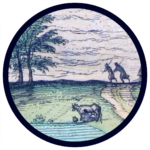Historic Polish estates in literature, music, and the visual arts

Real and fictional stately homes have appeared in – or played a key role in the creation of – some of the most significant and beloved Polish works of art.
Among the most famous such dwellings is the estate in the village of Chechły, near Czarnolas (“Blackwood”), to which the renowned Renaissance humanist and poet Jan Kochanowski (1530-1584) retired after years of service at the Polish royal court as secretary to King Sigismund II Augustus. That rustic Czarnolas manor provide an inspiring venue in which Kochanowski composed some of his most memorable, including the play The Dismissal of the Greek Envoys, the Laments, the poems “Na dom w Czarnolesie” and “Na lipę,” and his translation of the Psalms.
Other estates have featured prominently in works of literature like Adam Mickiewicz’s Pan Tadeusz (Master Thaddeus, 1834); Bolesław Prus’s Lalka (The Doll, 1890); Eliza Orzeszkowa’s novel Nad Niemnem (On the Niemen, 1888), with its fictional estate of Korczyn, modelled on the Dwór Kamieńskich in Miniewicze; and Stefan Żeromski’s novel Przediośnie (The Pre-Spring, 1924). Traditional Polish estates also served as centerpieces of many of the idyllic watercolor landscapes of Zygmunt Vogel (1764-1826).
Of special note is the dworek or small manor house in the village of Żelazowa Wola that was the birthplace of the composer Fryderyk Chopin (1810-1849). Chopin’s parents dwelt in the left oficyna or auxiliary wing of the manor house owned by the noble (though impoverished) Skarbek family, for whose children Chopin’s father Mikołaj served as governor. The main section of the dwór burned in 1812, and the right oficyna was destroyed during the First World War. However, the portion of the structure in which Fryderyk was born survives, and is today part of a park and museum dedicated to the composer. The lovingly restored oficyna retains much of its original traditional Mazovian architecture, along with other elements like a double-columned portico that were added in later eras.
